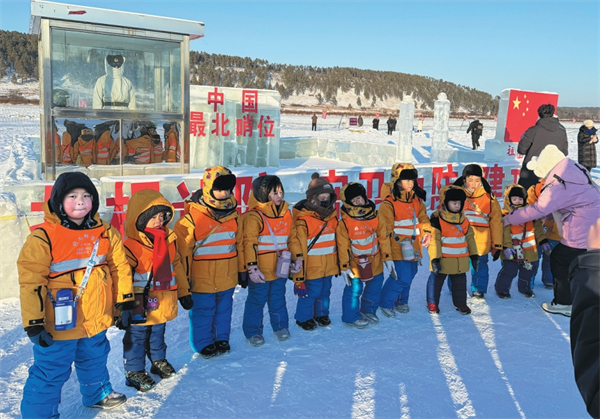Home>Harbin Today
Endangered storks flock to reserve in record numbers in NE China
Updated : 2015-11-03
By Zhou Huiying in Harbin and Che ( China Daily )
During their regular patrol to monitor birds in autumn, rangers with Naolihe National Nature Reserve in Heilongjiang province recorded a gathering of more than 700 Oriental storks, an endangered water bird.
According to Birdlife International, a global partnership of organizations that strives to conserve birds, the population of the large white birds with black wing feathers and long black bills is estimated at 3,000.
"We had never seen such a big aggregation before in our reserve," said Cui Xingbo, a ranger there. "I haven't heard of any bigger aggregation recorded from other nature reserves in the province."
The ranger said that the stork is a regularly seen in the region's wetlands, migrating there in spring, breeding there in summer, and heading south in autumn.
They have often recorded flocks with 100 to 200 birds in past autumns in the reserve, which covers more than 160,000 hectares.
"It's certainly a good sign and proof of the reserve's better conservation in recent years," he said.
The reserve was established in July 2002, integrating three provincial reserves and a city reserve. The national reserve has provided a larger and better habitat to birds, Cui said.
"Before the national reserve was established, people farmed, harvested reeds and reclaimed farmland from wetlands," he said.
"Now we have banned farming and have been trying to restore wetlands. Part of the reed bed where we saw the flock of Oriental storks was farmland before."
According to Cui, the reserve has 11 patrol stations and each has about 10 rangers responsible for regular patrols and monitoring.
Lei Jinyu, Yangtze species program manager of the World Wide Fund for Nature's Wuhan office, said the record reveals that the reserve can be considered as one of the most important stopover sites for Oriental storks in the world. "As far as I know, there was only one bigger count of about 900 Oriental storks recorded at Baidagang Reservoir in Tianjin," he said.
Mainly breeding in the Heilongjiang River and Ussuri River basins along the border of Russia and China, the storks winter in the lower Yangtze basin and southern China, Lei said. The storks have been considered a iconic species on the East Asia-Australia Flyway, a vast area stretching from the Arctic to Australia and New Zealand.
According to Cui, the rangers will keep an eye on the birds until they leave for the south.
Zhang Lei contributed to this story.

Harbin ramps up childcare services
A new comprehensive service center for childcare in Harbin is expected to be finished by the end of the year.
-
Talent policies drive enterprise development in Harbin
Harbin's "30 New Talent Policies" represents an iterative upgrade to the talent policy system, helping attract and retain talent to bolster economic and social development.
-
Official website of 2025 Asian Winter Games goes live
Harbin, the host city of the 9th Asian Winter Games, has announced that the official website for the 2025 event has recently gone live.
-
Harbin launches measures to facilitate more foreign trade
In the first three quarters of 2023, the total import and export value of Heilongjiang province's goods trade hit 218.22 billion yuan.





